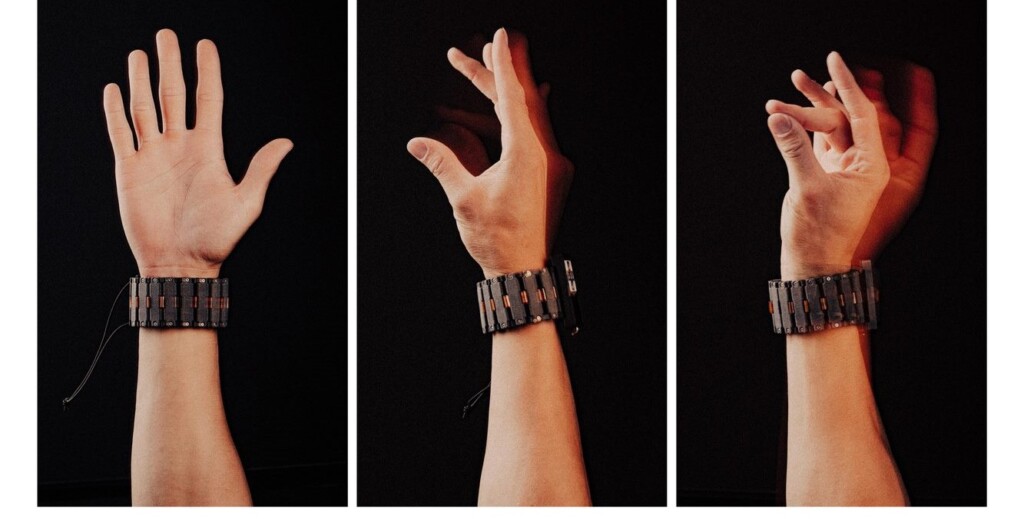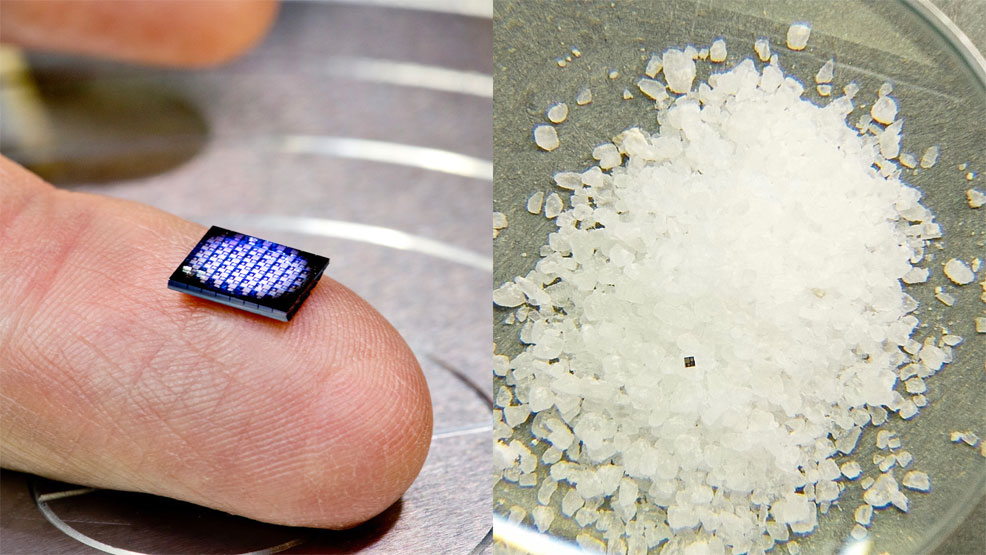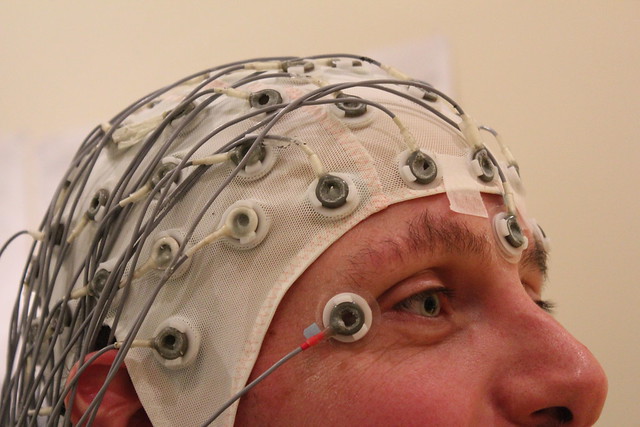 Meta’s Neuromotor Interface – credit, Reality Labs, via Springer Press
Meta’s Neuromotor Interface – credit, Reality Labs, via Springer PressThis Bracelet from Meta Translates Hand Movements into Computer Actions
 Meta’s Neuromotor Interface – credit, Reality Labs, via Springer Press
Meta’s Neuromotor Interface – credit, Reality Labs, via Springer PressAustralian researchers use a quantum computer to simulate how real molecules behave
When a molecule absorbs light, it undergoes a whirlwind of quantum-mechanical transformations. Electrons jump between energy levels, atoms vibrate, and chemical bonds shift — all within millionths of a billionth of a second.
These processes underpin everything from photosynthesis in plants and DNA damage from sunlight, to the operation of solar cells and light-powered cancer therapies.
Yet despite their importance, chemical processes driven by light are difficult to simulate accurately. Traditional computers struggle, because it takes vast computational power to simulate this quantum behaviour.
Quantum computers, by contrast, are themselves quantum systems — so quantum behaviour comes naturally. This makes quantum computers natural candidates for simulating chemistry.
Until now, quantum devices have only been able to calculate unchanging things, such as the energies of molecules. Our study, published this week in the Journal of the American Chemical Society, demonstrates we can also model how those molecules change over time.
We experimentally simulated how specific real molecules behave after absorbing light.
Simulating reality with a single ion
We used what is called a trapped-ion quantum computer. This works by manipulating individual atoms in a vacuum chamber, held in place with electromagnetic fields.
Normally, quantum computers store information using quantum bits, or qubits. However, to simulate the behaviour of the molecules, we also used vibrations of the atoms in the computer called “bosonic modes”.
This technique is called mixed qudit-boson simulation. It dramatically reduces how big a quantum computer you need to simulate a molecule.
We simulated the behaviour of three molecules absorbing light: allene, butatriene, and pyrazine. Each molecule features complex electronic and vibrational interactions after absorbing light, making them ideal test cases.
Our simulation, which used a laser and a single atom in the quantum computer, slowed these processes down by a factor of 100 billion. In the real world, the interactions take femtoseconds, but our simulation of them played out in milliseconds – slow enough for us to see what happened.
A million times more efficient
What makes our experiment particularly significant is the size of the quantum computer we used.
Performing the same simulation with a traditional quantum computer (without using bosonic modes) would require 11 qubits, and to carry out roughly 300,000 “entangling” operations without errors. This is well beyond the reach of current technology.
By contrast, our approach accomplished the task by zapping a single trapped ion with a single laser pulse. We estimate our method is at least a million times more resource-efficient than standard quantum approaches.
We also simulated “open-system” dynamics, where the molecule interacts with its environment. This is typically a much harder problem for classical computers.
By injecting controlled noise into the ion’s environment, we replicated how real molecules lose energy. This showed environmental complexity can also be captured by quantum simulation.
What’s next?
This work is an important step forward for quantum chemistry. Even though current quantum computers are still limited in scale, our methods show that small, well-designed experiments can already tackle problems of real scientific interest.
Simulating the real-world behaviour of atoms and molecules is a key goal of quantum chemistry. It will make it easier to understand the properties of different materials, and may accelerate breakthroughs in medicine, materials and energy.
We believe that with a modest increase in scale — to perhaps 20 or 30 ions — quantum simulations could tackle chemical systems too complex for any classical supercomputer. That would open the door to rapid advances in drug development, clean energy, and our fundamental understanding of chemical processes that drive life itself.![]()
Ivan Kassal, Professor of Chemical Physics, University of Sydney and Tingrei Tan, Research Fellow, Quantum Control Laboratory, University of Sydney
This article is republished from The Conversation under a Creative Commons license. Read the original article.
2025 will see huge advances in quantum computing. So what is a quantum chip and how does it work?
In recent years, the field of quantum computing has been experiencing fast growth, with technological advances and large-scale investments regularly making the news.
The United Nations has designated 2025 as the International Year of Quantum Science and Technology.
The stakes are high – having quantum computers would mean access to tremendous data processing power compared to what we have today. They won’t replace your normal computer, but having this kind of awesome computing power will provide advances in medicine, chemistry, materials science and other fields.
So it’s no surprise that quantum computing is rapidly becoming a global race, and private industry and governments around the world are rushing to build the world’s first full-scale quantum computer. To achieve this, first we need to have stable and scalable quantum processors, or chips.
What is a quantum chip?
Everyday computers – like your laptop – are classical computers. They store and process information in the form of binary numbers or bits. A single bit can represent either 0 or 1.
By contrast, the basic unit of a quantum chip is a qubit. A quantum chip is made up of many qubits. These are typically subatomic particles such as electrons or photons, controlled and manipulated by specially designed electric and magnetic fields (known as control signals).
Unlike a bit, a qubit can be placed in a state of 0, 1, or a combination of both, also known as a “superposition state”. This distinct property allows quantum processors to store and process extremely large data sets exponentially faster than even the most powerful classical computer.
There are different ways to make qubits – one can use superconducting devices, semiconductors, photonics (light) or other approaches. Each method has its advantages and drawbacks.
Companies like IBM, Google and QueRa all have roadmaps to drastically scale up quantum processors by 2030.
Industry players that use semiconductors are Intel and Australian companies like Diraq and SQC. Key photonic quantum computer developers include PsiQuantum and Xanadu.
Qubits: quality versus quantity
How many qubits a quantum chip has is actually less important than the quality of the qubits.
A quantum chip made up of thousands of low-quality qubits will be unable to perform any useful computational task.
So, what makes for a quality qubit?
Qubits are very sensitive to unwanted disturbances, also known as errors or noise. This noise can come from many sources, including imperfections in the manufacturing process, control signal issues, changes in temperature, or even just an interaction with the qubit’s environment.
Being prone to errors reduces the reliability of a qubit, known as fidelity. For a quantum chip to stay stable long enough to perform complex computational tasks, it needs high-fidelity qubits.
When researchers compare the performance of different quantum chips, qubit fidelity is one of the crucial parameters they use.
How do we correct the errors?
Fortunately, we don’t have to build perfect qubits.
Over the last 30 years, researchers have designed theoretical techniques which use many imperfect or low-fidelity qubits to encode an abstract “logical qubit”. A logical qubit is protected from errors and, therefore, has very high fidelity. A useful quantum processor will be based on many logical qubits.
Nearly all major quantum chip developers are now putting these theories into practice, shifting their focus from qubits to logical qubits.
In 2024, many quantum computing researchers and companies made great progress on quantum error corrections, including Google, QueRa, IBM and CSIRO.
Quantum chips consisting of over 100 qubits are already available. They are being used by many researchers around the world to evaluate how good the current generation of quantum computers are and how they can be made better in future generations.
For now, developers have only made single logical qubits. It will likely take a few years to figure out how to put several logical qubits together into a quantum chip that can work coherently and solve complex real-world problems.
What will quantum computers be useful for?
A fully functional quantum processor would be able to solve extremely complex problems. This could lead to revolutionary impact in many areas of research, technology and economy.
Quantum computers could help us discover new medicines and advance medical research by finding new connections in clinical trial data or genetics that current computers don’t have enough processing power for.
They could also greatly improve the safety of various systems that use artificial intelligence algorithms, such as banking, military targeting and autonomous vehicles, to name a few.
To achieve all this, we first need to reach a milestone known as quantum supremacy – where a quantum processor solves a problem that would take a classical computer an impractical amount of time to do.
Late last year, Google’s quantum chip Willow finally demonstrated quantum supremacy for a contrived task – a computational problem designed to be hard for classical supercomputers but easy for quantum processors due to their distinct way of working.
Although it didn’t solve a useful real-world problem, it’s still a remarkable achievement and an important step in the right direction that’s taken years of research and development. After all, to run, one must first learn to walk.
What’s on the horizon for 2025 and beyond?
In the next few years, quantum chips will continue to scale up. Importantly, the next generation of quantum processors will be underpinned by logical qubits, able to tackle increasingly useful tasks.
While quantum hardware (that is, processors) has been progressing at a rapid pace, we also can’t overlook an enormous amount of research and development in the field of quantum software and algorithms.
Using quantum simulations on normal computers, researchers have been developing and testing various quantum algorithms. This will make quantum computing ready for useful applications when the quantum hardware catches up.
Building a full-scale quantum computer is a daunting task. It will require simultaneous advancements on many fronts, such as scaling up the number of qubits on a chip, improving the fidelity of the qubits, better error correction, quantum software, quantum algorithms, and several other sub-fields of quantum computing.
After years of remarkable foundational work, we can expect 2025 to bring new breakthroughs in all of the above.![]()
Muhammad Usman, Head of Quantum Systems and Principal Research Scientist, CSIRO
This article is republished from The Conversation under a Creative Commons license. Read the original article.
DRDO’s young scientists complete testing of 6-qubit quantum processor

New Delhi, (IANS): Scientists from DRDO's Young Scientists Laboratory for Quantum Technologies (DYSL-QT) have completed end-to-end testing of a 6-qubit quantum processor, the Ministry of Defence said.
Musk plans largest-ever supercomputer for xAI startup: report

UK’s fastest supercomputer switched on

IBM developing world's smallest computer

Source: https://www.futuretimeline.net/
Computer program learns to replicate human handwriting
created by their automatic software. People were tricked by the computer-generated writing up to 40% of the time. Given how convincing it can be, some may believe this method could help in forging documents – but the team explained it works both ways and could actually help in detecting forgeries. "Forgery and forensic handwriting analysis are still almost entirely manual processes – but by taking the novel approach of viewing handwriting as texture-synthesis, we can use our software to characterise handwriting to quantify the odds that something was forged," explained Dr Gabriel Brostow, senior author. "For example, we could calculate what ratio of people start their 'o's' at the bottom versus the top and this kind of detailed analysis could reduce the forensics service's reliance on heuristics."Computer program learns to replicate human handwriting
A New Reality Materializing: Humans Can Be the New Supercomputer

- Contacts and sources: Jacob Sherson, Aarhus University,
- Citation: " Exploring the quantum speed limit with computer games" Authors: Jens Jakob W. H. Sørensen, Mads Kock Pedersen, Michael Munch, Pinja Haikka, Jesper Halkjær Jensen, Tilo Planke, Morten Ginnerup Andreasen, Miroslav Gajdacz, Klaus Mølmer, Andreas Lieberoth & Jacob F. Sherson Nature 532, 210–213 (14 April 2016) doi:10.1038/nature17620 http://dx.doi.org/10.1038/nature17620A, Source: http://www.ineffableisland.com/
Fastest ever brain-computer interface for spelling
Research helping build computers from DNA
Windows 10 may be selling well, how Microsoft are still not satisfied?
Nearly half of US jobs could be at risk of computerisation within 20 years
Mind Reading Computer Could Communicate With Coma Patients
 Western researchers have used neuroimaging to read human thought via brain activity when they are conveying specific ‘yes’ or ‘no’ answers. Their findings were published in The Journal of Neuroscience in a study titled, The Brain's Silent Messenger: Using Selective Attention to Decode Human Thought for Brain-Based Communication. According to lead researcher Lorina Naci, the interpretation of human thought from brain activity – without depending on speech or action – is one of the most provoking and challenging frontiers of modern neuroscience. Specifically, patients who are fully conscious and awake, yet, due to brain damage, are unable to show any behavioral responsivity, expose the limits of the neuromuscular system and the necessity for alternate forms of communication. Participants were asked to concentrate on a ‘yes’ or ‘no’ response to questions like “Are you married?” or “Do you have brothers and sisters?” and only think their response, not speak it. “This novel method allowed healthy individuals to answers questions asked in the scanner, simply by paying attention to the word they wanted to convey. By looking at their brain activity we were able to correctly decode the correct answers for each individual,” said Naci, a postdoctoral fellow at Western's Brain and Mind Institute. “The majority of volunteers conveyed their answers within three minutes of scanning, a time window that is well-suited for communication with brain-computer interfaces.” Naci and her Western colleagues Rhodri Cusack, Vivian Z. Jia and Adrian Owen are now utilizing this method to communicate with behaviorally non-responsive patients, who may be misdiagnosed as being in a vegetative state. “The strengths of this technique, especially its ease of use, robustness, and rapid detection, may maximize the chances that any such patient will be able to achieve brain-based communication,” Naci said. Contacts and sources: University of Western Ontario, Source: Nanopatents And Innovations, Reference-Image: flickr.com
Western researchers have used neuroimaging to read human thought via brain activity when they are conveying specific ‘yes’ or ‘no’ answers. Their findings were published in The Journal of Neuroscience in a study titled, The Brain's Silent Messenger: Using Selective Attention to Decode Human Thought for Brain-Based Communication. According to lead researcher Lorina Naci, the interpretation of human thought from brain activity – without depending on speech or action – is one of the most provoking and challenging frontiers of modern neuroscience. Specifically, patients who are fully conscious and awake, yet, due to brain damage, are unable to show any behavioral responsivity, expose the limits of the neuromuscular system and the necessity for alternate forms of communication. Participants were asked to concentrate on a ‘yes’ or ‘no’ response to questions like “Are you married?” or “Do you have brothers and sisters?” and only think their response, not speak it. “This novel method allowed healthy individuals to answers questions asked in the scanner, simply by paying attention to the word they wanted to convey. By looking at their brain activity we were able to correctly decode the correct answers for each individual,” said Naci, a postdoctoral fellow at Western's Brain and Mind Institute. “The majority of volunteers conveyed their answers within three minutes of scanning, a time window that is well-suited for communication with brain-computer interfaces.” Naci and her Western colleagues Rhodri Cusack, Vivian Z. Jia and Adrian Owen are now utilizing this method to communicate with behaviorally non-responsive patients, who may be misdiagnosed as being in a vegetative state. “The strengths of this technique, especially its ease of use, robustness, and rapid detection, may maximize the chances that any such patient will be able to achieve brain-based communication,” Naci said. Contacts and sources: University of Western Ontario, Source: Nanopatents And Innovations, Reference-Image: flickr.comProjectors to double brightness with polarisation breakthrough
Tech startup 3Gear doubles up on cameras for mm-sensitive gesture control
When a PC Knows Its Owner

get to know and respond to voice and gestures. Image: Screen Shot On Video
"LlibreOffice" Free And Delight-Full Alternative To MS-office

Its a very better off free package for home and business user, furnishing all kinds of strong suits as compare to contemporary demand or its even better whatever you want from an office package almost you can avail or more just give half an hour to understand its casual functionality and get ready as LibreOffice is spontaneous and easy to use, and Numerous masses who work with it all day have never faced at a manual – including moving Microsoft Office users, who normally discover all the characteristics they demand are in logical, easy-to-guess places. Plus, when you do need to check something, the built-in help is a valuable aid that answers most of your inquiries. But, for numerous masses, aught renews a good user escort that Teaches you step-by-step how to do what you condition to do. Accomplished LibreOffice user guides are available at following links LibreOffice: "Documentation" as well this page on the wiki. to confirm the composition of the package as per your requirements if you want to obtain this free opportunity, you need to click on following Link: Download or visit another link for your choice of downloads http://www.libreoffice.org/download/, Image: flickr.com
By 2018 computers 'will have 5 senses
Some day soon, you'll be able to order a wedding dress on your tablet and feel the fabric and the veil just by touching the screen. When you feel an object, your brain registers the series of vibrations on your skin as being smooth, rough, sharp, etc. Computer sensors are becoming sophisticated enough to do that too.Within the next five years, vibrators within smartphones will be precise enough that they could be designed to mimic the vibrations experienced when your fingers touch a particular surface. Even though you'll just be touching glass, it will feel like you're touching whatever object is displayed on the screen. Source: The Coming Crisis
US Titan Supercomputer Clocked as World's Fastest
TENNESSEE, USA – The top two spots on the list of the world's most powerful supercomputers have both been captured by the US. The last time the country was in a similar position was three years ago. The fastest machine - Titan, at Oak Ridge National Laboratory in Tennessee - is an upgrade of Jaguar, the system which held the top spot in 2009. The supercomputer will be used to help develop more energy-efficient engines for vehicles, model climate change and research biofuels. It can also be rented to third-parties, and is operated as part of the US Department of Energy's network of research labs. The Top 500 list of supercomputers was published by Hans Muer, professor of computer science at Mannheim, who has been keeping track of developments since 1986. It was released at the SC12 supercomputing conference in Salt Lake City, Utah.Mixed processors Titan leapfrogged the previous champion IBM's Sequoia - which is used to carry out simulations to help extend the life of nuclear weapons - thanks to its mix of central processing unit (CPU) and graphics processing unit (GPU) technologies. According to the Linpack benchmark it operates at 17.59 petaflop/sec - the equivalent of 17,590 trillion calculations per second. The benchmark measures real-world performance - but in theory the machine can boost that to a "peak performance" of more than 20 petaflop/sec. To achieve this the device has been fitted with 18,688 Tesla K20x GPU modules made by Nvidia to work alongside its pre-existing CPUs. Traditionally
supercomputers relied only on CPUs. CPU cores are designed to carry out a single set of instructions at a time, making them well suited for tasks in which the answer to one calculation is used to work out the next. GPU cores are typically slower at carrying out individual calculations, but make up for this by being able to carry out many at the same time. This makes them best suited for "parallellisable jobs" - processes that can be broken down into several parts that are then run simultaneously. Mixing CPUs and GPUs together allows the most appropriate core to carry out each process. Nvidia said that in most instances its GPUs now carried out about 90% of Titan's workload. "Basing Titan on Tesla GPUs allows Oak Ridge to run phenomenally complex applications at scale, and validates the use of 'accelerated computing' to address our most pressing scientific problems," said Steve Scott, chief technology officer of the GPU accelerated computing business at Nvidia. The other top systems included: (1) Fujitsu's K computer at the Riken Advanced Institute for Computational Science in Kobe, Japan, which was in third spot. (2) IBM's BlueGene/Q Mira computer at Argonne National Library, near Chicago in the US, which came fourth. (3) Another IBM BlueGene/Q system, called Juqueen, at the Forschungszentrum Juelich in Germany - Europe's fastest - which came fifth. Out of the top 500 computers, 62 used a mix of CPU and GPU processors. Six months ago the figure was 58. Source: Korea Times




